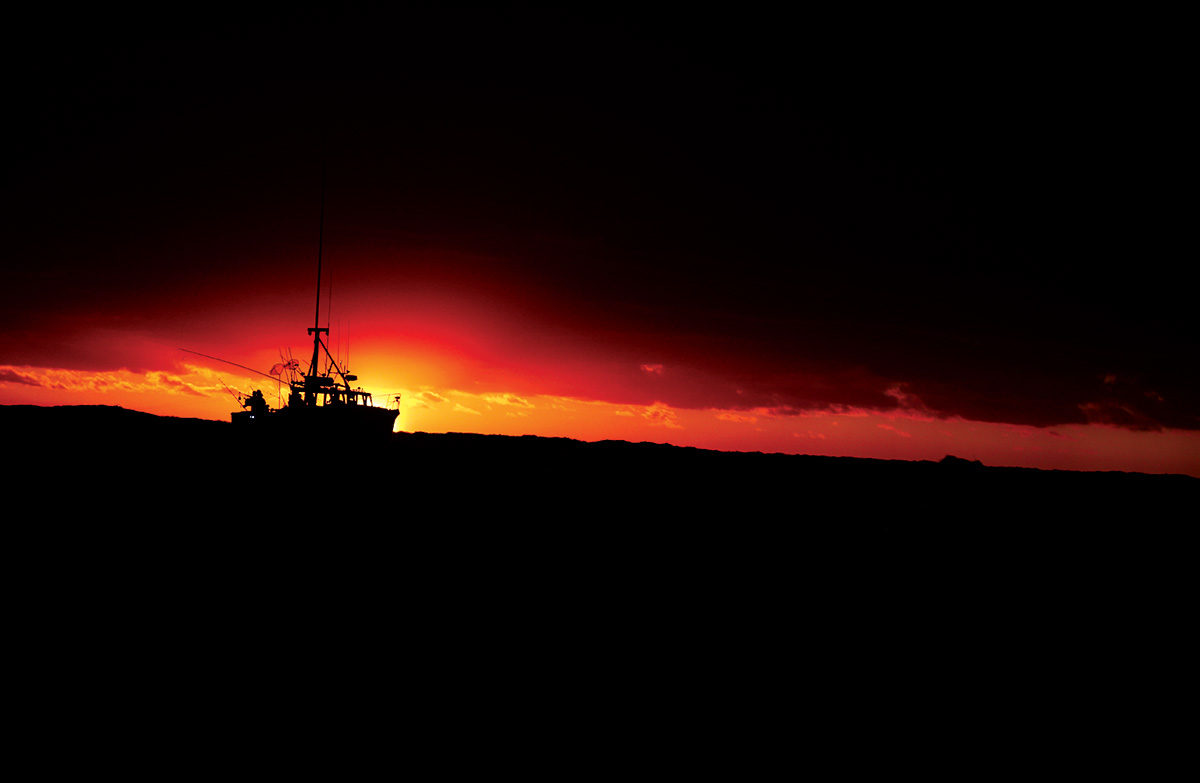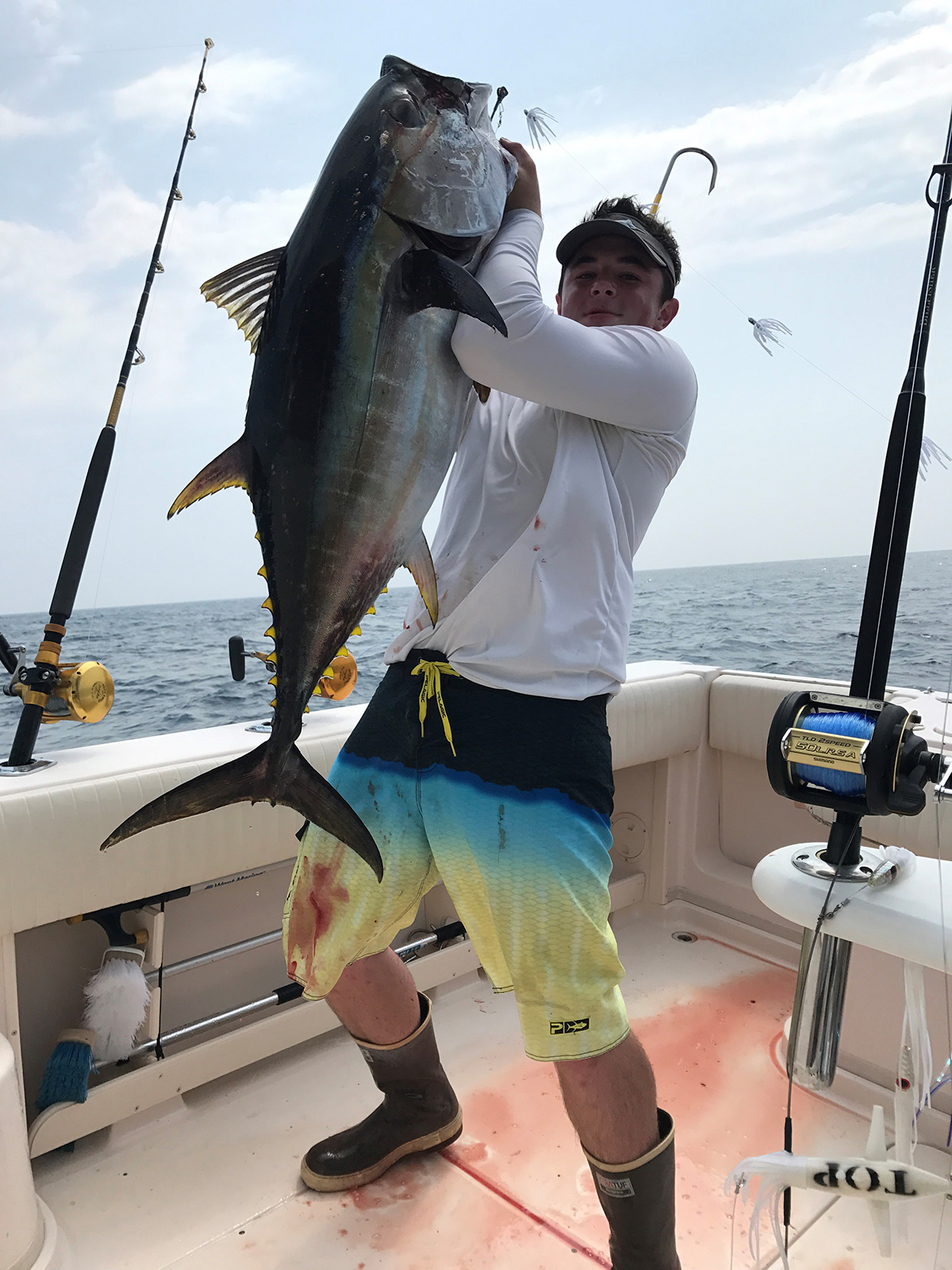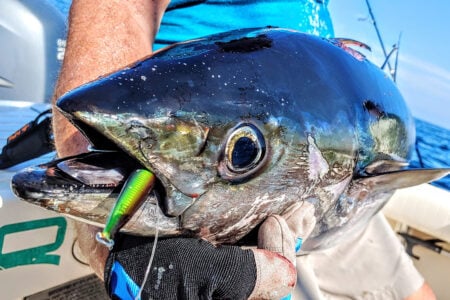
If bigeye trolling at night is not your cup of tea, get on the drift!
During the last few years bigeye tuna have made a significant appearance in the canyons. Early on we did the traditional trolling of big lures at early morning darkness into grey light then again evening into darkness; it’s a method that has led to bigeye success for many folks on the offshore grounds over the years.
However, over time I found it was taking too much effort. The successful trips were getting less and less successful. I believe there were a few reasons for that; once the bite was on the boat traffic got beyond insane with boats fishing rigger to rigger, green stick boats from up and down the coast pulling their effective gear, and more importantly effective trolling techniques from the majority of the fleet.
Of course, you also had the “ineffective” trolling techniques from a very small percentage of offshore fishermen, which was just enough of a number to make night trolling a bit dangerous to say the least. Finding active bigeye on the night bite is a truly competitive endeavor; and having been a competitive person my entire life, I’ve always enjoyed the competition for fish.
Of course, it’s not always as much fun when you’re competing on a daily and nightly basis. As a charter boat captain looking for an edge at the edge, I’ve made a little change to the way we fish for bigeye aboard Andrea’s Toy.
Change of Tactics
Last year I decided to swit ch up our bigeye techniques to fish smarter, not harder. Now, when I arrive in the canyons usually the hotspot has already been identified from previous reports; if not I begin my own recon. During my offshore search I look for the pilot whales. Once I find the whales the bait is usually beneath them and so are the fish. However, most of the time they are down deep 100 to 300 feet and not interested in rising to my trolling spread. Most of this behavior is due to the bigeye’s preference for the deep during daylight hours.
While trolling at light I mark waypoints on my plotter with at least three different schools of fish marked deep, pods of pilot whales, or schools of baitfish deep. As night approaches the fish rise in the column and become more active. Rather than troll with the fleet I figure out my drift with current and wind and fish a pod of whales/bait/fish and begin chunking a mile ahead from the areas of life I identified during my recon.
The first baits deployed are my deep baits; squid down 150 feet, another at 100 feet, then three free-lined baits including a squid, a butterfish and a sardine in my chunk slick. To spread my chum slick I use a Chumchunker, which automatically drops chunks in the water via a mini conveyor belt.
At this point I simply monitor my fishfinder and see where I am marking the tuna and adjust my deep baits accordingly. I usually spend at least an hour drifting in the life that I identified, and if there are no bites, no fish rising in the water column, or fish darting in my slick, I move onto the next spot I identified previously.

Eyeball Gear
Preparation is the key for this type of fishing, and the gear I use is lightweight yet powerful. It consists of a Shimano Tallica 16, a two-speed reel matched to a Shimano Terez rated for 200 pounds. I use 65-pound Power Pro Depth Hunter colored braid, which allows any angler working in the cockpit to easily set out the appropriate amount of depth; to that I add a 25-yard top shot of 65-pound Momoi Diamond. I like to connect my top shot via a Spro power swivel to a 6-foot section of 60- or 80-pound fluorocarbon leader tied to a 3/0 or 5/0 circle depending on the bait I use.
To properly present the baits deep I use either a 5- or 8-ounce egg sinker ahead of the barrel swivel. If targeting smaller fish that may be present like yellowfin or longfin, I scale down to 30-pound leader and smaller hooks if I see them zooming in my slick during the daylight hours. I always have a pair of jigging and popping rods ready if fish are not responding to the baits. For spinners I use the Saragosa 18000 paired to 7-foot Terez popping rod, which is ideal for throwing Shimano Orca poppers and Waxwings. For jigging I use the same Tallica 16s with small Shimano flat side and butterfly jigs.
Once we started utilizing this technique aboard Andrea’s Toy working the offshore grounds I noticed some great benefits. First of all, trolling is effective but I feel that chunking and jigging is simply more fun, especially when you visually see the fish coming into your slick. Second, trolling in darkness has its risks; minimizing dangers in offshore fishing certainly has its plusses. Third, I personally have more energy through the day and night as a captain if not trolling an extended amount of time. This type of fishing gets the crew more involved, which makes for a more attentive, less bored group of anglers in the cockpit.
The first time I used this approach was during the Manasquan River Marlin and Tuna Club’s annual Offshore Open a few years ago around the full moon in August (In 2017 that occurs on August 7 as of 2:11 p.m.) and was able to successfully land three 200-pound bigeye in succession all before dark. I have also landed tuna using this technique in the morning. Tuna trolling prior to sunrise during grey light is effective, however as the sun rises and fish go deep, the same technique can be used. Follow the same game plan, find the fish/whales/bait and try to troll; if no takers deploy the same spread. I have successfully caught longfin, yellowfin and bigeye all in the same area using these techniques.
With the increasing presence of bigeye on the offshore grounds in recent years, this technique is simply another tool in the box to increase your odds to make that run to the edge a success. For the offshore crew that would like to jump on the bigeye bite but prefers not trolling throughout the night, this is a tool to employ rather quickly this month as that action gets underway.
Tight lines and safe fishing!
A longtime contributor to The Fisherman, the author runs a 31 Contender FA out of Point Pleasant Beach, NJ; he’s also on the advisory committee for the International Commission for the Conservation of Atlantic Tunas (ICCAT) which is responsible for management and conservation of Atlantic tunas.
| NOAA FACTS BIGEYE BASICS |
|---|
| The minimum size for yellowfin and bigeye tuna is 27 inches curved fork length. However, while there is a three fish per person/day/trip yellowfin tuna retention limit, there are no recreational limits for bigeye (or skipjack, or albacore). The problem is that bigeye (also known as ahi) and yellowfin tuna look very similar; even NOAA Fisheries acknowledges “it’s hard to distinguish the two species without experience.” Telltale signs you’ve boated a bigeye are finlets with black edges and the bigeye’s eyes are larger than the yellowfin’s.
According to the 2015 stock assessment, Atlantic bigeye tuna are not overfished and are rebuilding to target population levels. The next ICCAT assessment of bigeye is expected in 2018. |




